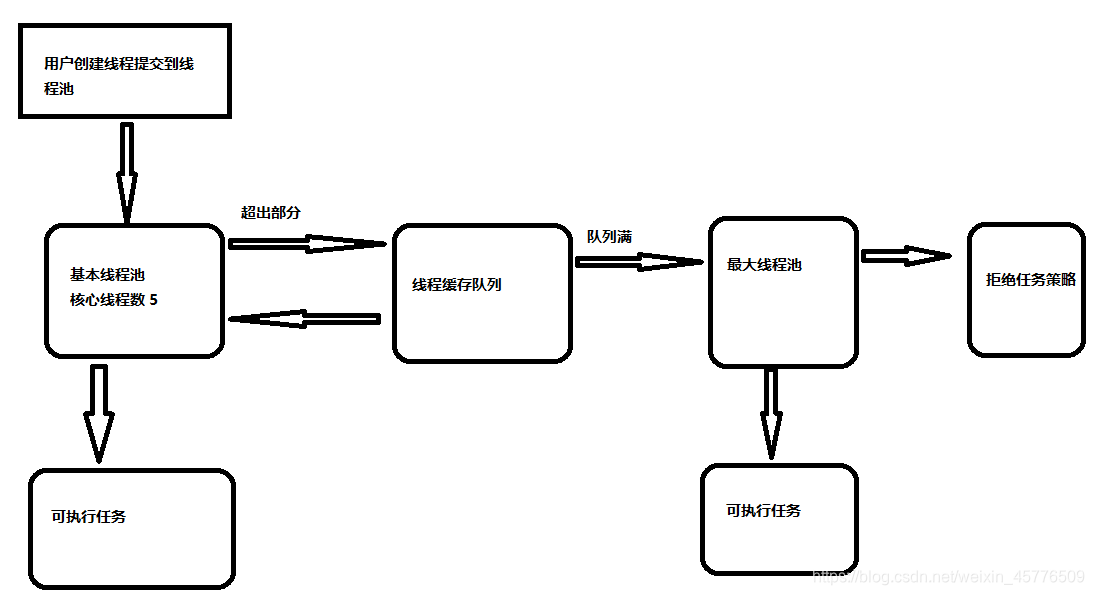经常创建,启动,销毁一个线程都是非常耗时间的。使用线程池进行管理服务线程,提高程序效率。
1.重复利用
2.提高响应速度
3.管理线程---线程池进行创建和分配。--队列
java中使用线程核心走ThreadPoolExecutor
线程池的最上层接口是Executor,这个接口定义了一个核心方法execute(Runnabel command),这个方法最后被ThreadPoolExecutor类实现,这个方法是用来传入任务的。而且ThreadPoolExecutor是线程池的核心类,此类的构造方法如下:
public ThreadPoolExecutor(int corePoolSize,int maximumPoolSize,long keepAliveTime,TimeUnit unit,
BlockingQueue<Runnable> workQueue);
public ThreadPoolExecutor(int corePoolSize,int maximumPoolSize,long keepAliveTime,TimeUnit unit,
BlockingQueue<Runnable> workQueue,ThreadFactory threadFactory);
public ThreadPoolExecutor(int corePoolSize,int maximumPoolSize,long keepAliveTime,TimeUnit unit,
BlockingQueue<Runnable> workQueue,RejectedExecutionHandler handler);
public ThreadPoolExecutor(int corePoolSize,int maximumPoolSize,long keepAliveTime,TimeUnit unit,
BlockingQueue<Runnable> workQueue,ThreadFactory threadFactory,RejectedExecutionHandler handler);
构造方法的参数及意义:
corePoolSize:核心线程池的大小,如果核心线程池有空闲位置,这是新的任务就会被核心线程池新建一个线程执行,执行完毕后不会销毁线程,线程会进入缓存队列等待再次被运行。
maximunPoolSize:线程池能创建最大的线程数量。如果核心线程池和缓存队列都已经满了,新的任务进来就会创建新的线程来执行。但是数量不能超过maximunPoolSize,否侧会采取拒绝接受任务策略。
keepAliveTime:非核心线程能够空闲的最长时间,超过时间,线程终止。这个参数默认只有在线程数量超过核心线程池大小时才会起作用。只要线程数量不超过核心线程大小,就不会起作用。
unit:时间单位,和keepAliveTime配合使用。
workQueue:缓存队列,用来存放等待被执行的任务。
threadFactory:线程工厂,用来创建线程
handler:拒绝处理策略,线程数量大于最大线程数就会采用拒绝处理策略
提交一个任务到线程池中,线程池的处理流程如下:
1.判断线程池里的核心线程是否都在执行任务,如果不是(核心线程空闲或者还有核心线程没有被创建)则创建一个新的工作线程来执行任务。如果核心线程都在执行任务,则进入下个流程。
2.线程池判断工作队列是否已满,如果工作队列没有满,则将新提交的任务存储在这个工作队列里。如果工作队列满了,则进入下个流程。
3.判断线程池里的线程是否都处于工作状态,如果没有,则创建一个新的工作线程来执行任务。如果已经满了,则交给饱和策略来处理这个任务。

import java.util.concurrent.ExecutorService;
import java.util.concurrent.Executors;
/**
* @author shkstart
*
*/
public class Test1 {
public static void main(String[] args) {
//1.可缓存的线程池,重复利用newCachedThreadPool
ExecutorService newCachedThreadPool = Executors.newCachedThreadPool();
for (int i = 0; i <20 ; i++) {
int temp=i;
newCachedThreadPool.execute(new Runnable() {
@Override
public void run() {
try {
Thread.sleep(500);
} catch (InterruptedException e) {
e.printStackTrace();
}
System.out.println("threadName:"+Thread.currentThread().getName()
+",i:"+temp);
}
});
}
//2.可固定长度线程池newFixedThreadPool
// ExecutorService newFixedThreadPool = Executors.newFixedThreadPool(3);
// for (int i = 0; i <10 ; i++) {
// int temp=i;
// newFixedThreadPool.execute(new Runnable() {
// @Override
// public void run() {
// System.out.println("threadName:"+Thread.currentThread().getName()
// +",i:"+temp);
// }
// });
// }
//
//
//
// //3.可定时线程池newScheduledThreadPool
// ScheduledExecutorService newScheduledThreadPool = Executors.newScheduledThreadPool(3);
// for (int i = 0; i <10 ; i++) {
// int temp=i;
// newScheduledThreadPool.schedule(new Runnable() {
// @Override
// public void run() {
// try {
// Thread.sleep(500);
// } catch (InterruptedException e) {
// e.printStackTrace();
// }
// System.out.println("threadName:"+Thread.currentThread().getName()
// +",i:"+temp);
// }
// },5, TimeUnit.SECONDS);
// }
// newScheduledThreadPool.shutdown();
//
//
// public void test4(){
// //4.单线程newSingleThreadScheduledExecutor
// ScheduledExecutorService newSingleThreadScheduledExecutor = Executors.newSingleThreadScheduledExecutor();
// for (int i = 0; i <10 ; i++) {
// int temp=i;
// newSingleThreadScheduledExecutor.execute(new Runnable() {
// @Override
// public void run() {
// try {
// Thread.sleep(500);
// } catch (InterruptedException e) {
// e.printStackTrace();
// }
// System.out.println("threadName:"+Thread.currentThread().getName()
// +",i:"+temp);
// }
// });
// }
// newSingleThreadScheduledExecutor.shutdown();
}
}























 170万+
170万+

 被折叠的 条评论
为什么被折叠?
被折叠的 条评论
为什么被折叠?








